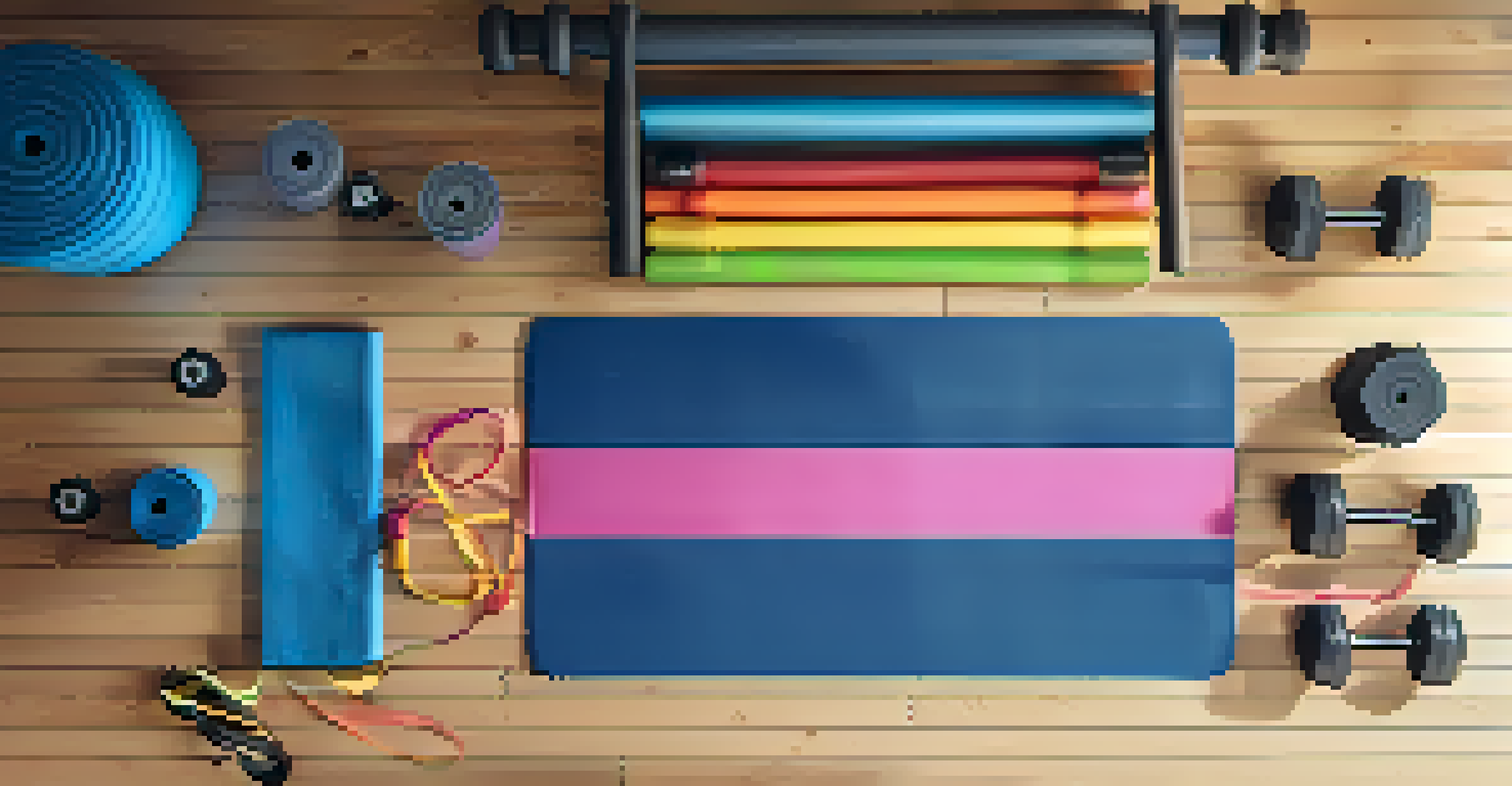Utilizing Resistance Bands for Effective Strength Training

What Are Resistance Bands and Their Benefits?
Resistance bands are versatile exercise tools made of elastic material designed to provide resistance during workouts. They come in various thicknesses and lengths, allowing users to choose the level of difficulty that suits their fitness levels. One of the main benefits of resistance bands is their portability, making them perfect for home workouts or travel.
Strength does not come from physical capacity. It comes from an indomitable will.
Additionally, resistance bands can help improve muscle tone and strength without the need for heavy weights. They engage multiple muscle groups at once, promoting functional strength that's applicable in daily activities. This makes them an excellent choice for both beginners and advanced athletes alike, as they can easily adjust their routines.
Moreover, using resistance bands can help enhance flexibility and joint stability. The bands allow for a greater range of motion, which can lead to improved overall mobility. By incorporating resistance bands into your training, you can foster a well-rounded fitness routine that emphasizes strength and flexibility.
Getting Started: Choosing the Right Resistance Bands
When choosing resistance bands, it's important to consider your fitness goals and current strength level. Bands typically come in different colors and resistance levels, ranging from light to heavy. Beginners might want to start with lighter bands to master form and technique before progressing to heavier options.

It's also wise to look for bands with handles or ankle straps for added versatility. These attachments can make it easier to perform various exercises targeting different muscle groups. Additionally, consider investing in bands made from durable materials to ensure they withstand regular use without snapping.
Benefits of Resistance Bands
Resistance bands are portable, versatile tools that improve strength, flexibility, and muscle tone.
Finally, think about your workout space when selecting resistance bands. If you're short on space, opt for compact bands that can be easily stored. This way, you can maintain your strength training routine without it becoming a hassle.
Basic Exercises to Kick Off Your Resistance Band Training
To get started with resistance bands, a great introductory exercise is the banded squat. Stand on the band with your feet shoulder-width apart, holding the handles at shoulder height. As you squat down, the band will provide resistance, helping to strengthen your legs and core.
The only bad workout is the one that didn't happen.
Another effective exercise is the seated row. Sit with your legs extended in front of you, loop the band around your feet, and pull the handles towards your torso. This movement targets your back muscles and helps improve posture, making it an excellent addition to your routine.
Don't forget about the banded chest press! Anchor the band behind you, hold the handles at chest level, and push forward. This exercise engages your chest, shoulders, and triceps, creating a well-rounded upper body workout. By incorporating these basics, you'll build a solid foundation for your resistance band training.
Incorporating Resistance Bands into Your Routine
One of the best ways to incorporate resistance bands into your training routine is by adding them to your existing workouts. For example, you can use bands to enhance bodyweight exercises like push-ups or lunges. Simply loop the band around your back for push-ups or under your front foot for lunges to increase the challenge.
Additionally, consider creating a dedicated resistance band workout session. This could include a series of exercises targeting your major muscle groups, allowing for a full-body workout in a short amount of time. The flexibility of resistance bands means you can easily customize these workouts to fit your needs.
Choosing the Right Bands
Selecting the appropriate resistance level and features, like handles or straps, is crucial for effective workouts.
Lastly, don't be afraid to mix things up! Combining resistance bands with traditional weights or other equipment can keep your workouts fresh and engaging. This variety helps prevent boredom and ensures you continue making progress toward your fitness goals.
Common Mistakes to Avoid with Resistance Bands
One common mistake when using resistance bands is not selecting the appropriate resistance level. Using bands that are too light may not provide enough challenge, while bands that are too heavy can lead to poor form and potential injury. It's crucial to find the right balance that allows for proper technique while still challenging your muscles.
Another pitfall is neglecting to warm up before workouts. Just like any other strength training, warming up is essential to prepare your muscles and joints for the session ahead. A proper warm-up can help prevent injury and enhance overall performance during your resistance band exercises.
Lastly, many people forget to focus on their breathing during workouts. Proper breathing techniques can improve your performance and endurance. Remember to exhale during the exertion phase of the exercise and inhale as you return to the starting position.
Tracking Progress While Using Resistance Bands
Tracking your progress is an important aspect of any fitness routine, including strength training with resistance bands. Start by noting the resistance level you use and the number of repetitions for each exercise. This information will help you gauge your progress over time and determine when to increase resistance or intensity.
Consider taking photos or measurements to visually document your progress. Sometimes, the changes in your physique may not be immediately apparent in the mirror, but photographs can provide a clearer picture of your transformation. Tracking your progress can keep you motivated and focused on your goals.
Avoiding Common Mistakes
To maximize your resistance band training, avoid using incorrect resistance levels, neglecting warm-ups, and forgetting proper breathing techniques.
Additionally, keep a workout journal to record your feelings and energy levels during each session. This reflection can help you identify which exercises you enjoy most and what areas you might need to work on. By monitoring your journey, you'll stay engaged and excited about your resistance band training.
Staying Motivated with Resistance Band Workouts
Staying motivated is key to maintaining a consistent workout routine, and resistance bands can help with that. Their versatility means you can easily change up your workouts, preventing monotony. Set specific goals, such as completing a certain number of workouts each week or mastering new exercises, to keep yourself engaged.
Joining a community or finding a workout buddy can also boost your motivation. Sharing your journey with others can lead to accountability and encouragement. Consider participating in online forums or local fitness classes that focus on resistance band training to connect with like-minded individuals.

Lastly, celebrate your successes! Whether it's increasing your resistance level or completing a challenging workout, acknowledging your achievements can foster a positive mindset. By focusing on your progress and the enjoyment of your workouts, you'll be more likely to stick with your resistance band training in the long run.